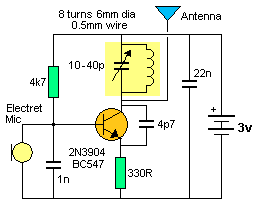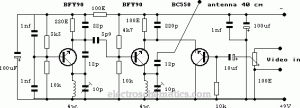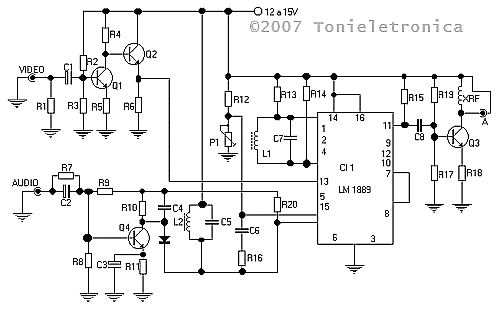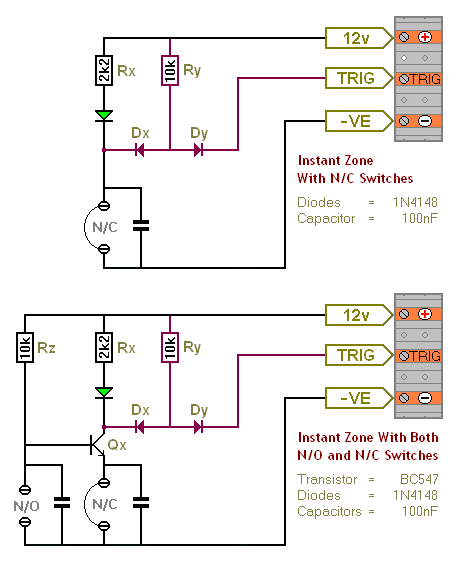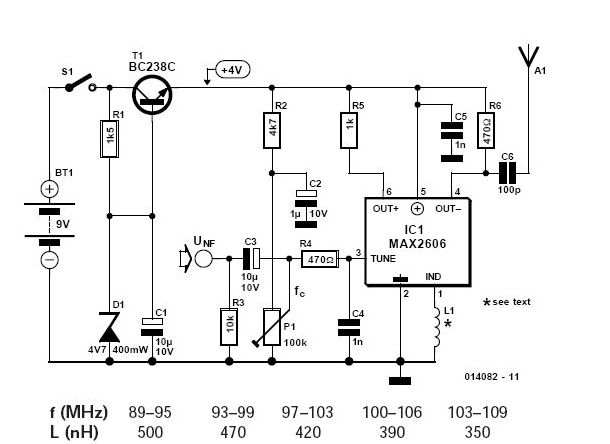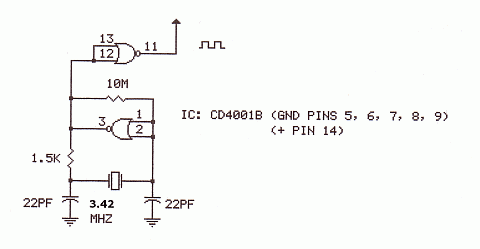
2 transistor fm voice transmitter

This circuit functions as a voice transmitter utilizing a pair of BC548 transistors. While these transistors are not specifically designed for RF applications, they still yield satisfactory performance. An ECM microphone insert from Maplin Electronics, order code FS43W, is employed. This microphone features two terminals, but standard dynamic microphone inserts can also be utilized by omitting the front 10k resistor. The circuit includes a coil, L1, sourced from Maplin, part number UF68Y, which consists of seven turns wound onto a quarter-inch plastic former with an adjustable tuning slug. This tuning slug is used to fine-tune the transmitter's frequency. The prototype demonstrated a frequency range from approximately 70 MHz to 120 MHz. The antenna is constructed from a few inches of wire; lengths exceeding two feet may dampen oscillations and impede circuit functionality. Although RF circuits are ideally assembled on a printed circuit board (PCB), it is possible to use veroboard, provided that all leads are kept short and track breaks are implemented at the necessary points. It is also important to avoid holding the circuit while speaking, as body capacitance acts as a 200 pF capacitor shunted to ground, which can dampen oscillations.
The voice transmitter circuit is designed around the BC548 transistors, which serve as the primary amplification components. The circuit operates by converting audio signals from the microphone into radio frequency (RF) signals. The ECM microphone captures sound waves, converting them into electrical signals. These signals are fed into the base of the first BC548 transistor, which amplifies the audio signal. The amplified signal is then fed into the second BC548 transistor, which further boosts the signal strength before it is modulated onto the RF carrier wave generated by the coil L1.
The coil L1 plays a critical role in determining the operating frequency of the transmitter. The seven turns of wire wound onto a plastic former create an inductor that, in combination with the capacitive elements of the circuit, establishes the resonant frequency. The tuning slug allows for fine adjustments to the inductance, enabling the user to precisely tune the transmitter to the desired frequency range. The prototype's frequency range of 70 MHz to 120 MHz is typical for low-power voice transmitters, suitable for short-distance communication.
The antenna design is also crucial for effective transmission. A short wire antenna is sufficient for this application, as it allows for efficient radiation of the RF signals. However, lengths greater than two feet may introduce unwanted capacitance and inductance effects, which can lead to signal loss and reduced transmission range.
For optimal performance, it is recommended to construct the circuit on a PCB, as this minimizes lead lengths and potential interference. However, if a PCB is not available, a veroboard can be used, ensuring that all connections are secure and that track breaks are made where necessary to prevent undesired feedback loops.
Finally, it is essential to be mindful of the circuit's operation while in use. Holding the circuit can introduce body capacitance, which can significantly affect the performance by damping oscillations. To mitigate this issue, the circuit should be placed on a stable surface during operation, allowing for clear audio transmission without interference from external capacitance.This is a circuit for voice transmitter using a pair of BC548 transistors in this circuit. Although not strictly RF transistors, they still give good results. I have used an ECM Mic insert from Maplin Electronics, order code FS43W. It is a two terminal ECM, but ordinary dynamic mic inserts can also be used, simply omit the front 10k resistor. This is the figure of the circuit; The coil L1 was again from Maplin, part no. UF68Y and consists of 7 turns on a quarter inch plastic former with a tuning slug. The tuning slug is adjusted to tune the transmitter. Actual range on my prototype tuned from 70MHz to around 120MHz. The aerial is a few inches of wire. Lengths of wire greater than 2 feet may damp oscillations and not allow the circuit to work. Although RF circuits are best constructed on a PCB, you can get away with veroboard, keep all leads short, and break tracks at appropriate points. One final point, don`t hold the circuit in your hand and try to speak. Body capacitance is equivalent to a 200pF capacitor shunted to earth, damping all oscillations. 🔗 External reference
The voice transmitter circuit is designed around the BC548 transistors, which serve as the primary amplification components. The circuit operates by converting audio signals from the microphone into radio frequency (RF) signals. The ECM microphone captures sound waves, converting them into electrical signals. These signals are fed into the base of the first BC548 transistor, which amplifies the audio signal. The amplified signal is then fed into the second BC548 transistor, which further boosts the signal strength before it is modulated onto the RF carrier wave generated by the coil L1.
The coil L1 plays a critical role in determining the operating frequency of the transmitter. The seven turns of wire wound onto a plastic former create an inductor that, in combination with the capacitive elements of the circuit, establishes the resonant frequency. The tuning slug allows for fine adjustments to the inductance, enabling the user to precisely tune the transmitter to the desired frequency range. The prototype's frequency range of 70 MHz to 120 MHz is typical for low-power voice transmitters, suitable for short-distance communication.
The antenna design is also crucial for effective transmission. A short wire antenna is sufficient for this application, as it allows for efficient radiation of the RF signals. However, lengths greater than two feet may introduce unwanted capacitance and inductance effects, which can lead to signal loss and reduced transmission range.
For optimal performance, it is recommended to construct the circuit on a PCB, as this minimizes lead lengths and potential interference. However, if a PCB is not available, a veroboard can be used, ensuring that all connections are secure and that track breaks are made where necessary to prevent undesired feedback loops.
Finally, it is essential to be mindful of the circuit's operation while in use. Holding the circuit can introduce body capacitance, which can significantly affect the performance by damping oscillations. To mitigate this issue, the circuit should be placed on a stable surface during operation, allowing for clear audio transmission without interference from external capacitance.This is a circuit for voice transmitter using a pair of BC548 transistors in this circuit. Although not strictly RF transistors, they still give good results. I have used an ECM Mic insert from Maplin Electronics, order code FS43W. It is a two terminal ECM, but ordinary dynamic mic inserts can also be used, simply omit the front 10k resistor. This is the figure of the circuit; The coil L1 was again from Maplin, part no. UF68Y and consists of 7 turns on a quarter inch plastic former with a tuning slug. The tuning slug is adjusted to tune the transmitter. Actual range on my prototype tuned from 70MHz to around 120MHz. The aerial is a few inches of wire. Lengths of wire greater than 2 feet may damp oscillations and not allow the circuit to work. Although RF circuits are best constructed on a PCB, you can get away with veroboard, keep all leads short, and break tracks at appropriate points. One final point, don`t hold the circuit in your hand and try to speak. Body capacitance is equivalent to a 200pF capacitor shunted to earth, damping all oscillations. 🔗 External reference
